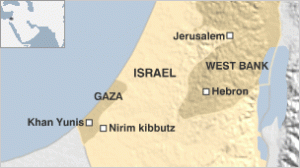 Nowhere else in the world can you find two countries that are so close to each other geographically but have such a huge difference in their per capita income as Israel, on the one hand, and Palestine’s West Bank and Gaza regions on the other, according to Zvi Eckstein, a former deputy governor of the Bank of Israel and a visiting professor at Wharton. During a recent lecture titled, “West Bank Economic Development and Industrialization,” Eckstein noted that while the per capita income in the West Bank is less than two thousand dollars a year, Israel’s is just above $30,000 — and policymakers in that country are hoping to move even higher up the ranks of the world’s emerging economies.
Nowhere else in the world can you find two countries that are so close to each other geographically but have such a huge difference in their per capita income as Israel, on the one hand, and Palestine’s West Bank and Gaza regions on the other, according to Zvi Eckstein, a former deputy governor of the Bank of Israel and a visiting professor at Wharton. During a recent lecture titled, “West Bank Economic Development and Industrialization,” Eckstein noted that while the per capita income in the West Bank is less than two thousand dollars a year, Israel’s is just above $30,000 — and policymakers in that country are hoping to move even higher up the ranks of the world’s emerging economies.
Eckstein argued that this growing divergence between the economic status of Israel and its closest neighbor will create enormous challenges for policymakers on both sides of the border, even assuming Israelis and Palestinians eventually forge a lasting peace treaty. This vast economic distance has made the West Bank and Gaza highly dependent on Israel’s economy for jobs, transfer payments, tax collections, foreign trade and other growth opportunities. During his talk, Eckstein posed this key question: “If we assume the solution [to the peace problem] will be two independent states, what kind of economic relationship between Palestine and Israel” will be most suitable for the interests of both Palestinians and Israelis?
In an age of globalization, many pundits and policymakers have assumed that a lasting peace between Israel and its neighbors will inevitably lead to even closer economic integration between the economies of the region. However, Eckstein questioned the wisdom of that approach. “I don’t think it is a good idea” to preserve all the close links between the two economies, he said. “An economy with a per capita income of $2,000 cannot work well with one that has income of $30,000.” Although Israel suffers from “huge problems of income distribution,” even the minimum wage in Israel is about two and a half to three times as high as the average wage in the West Bank. The average construction worker in Israel, for example, makes more money than even a skilled high-tech worker in the West Bank or Gaza. “We can’t integrate the two markets,” he said. “We must manage the markets,” instead, if we want to “develop long-term human capital” in the West Bank and Gaza.
To date, the path of economic integration between the two economies has created a series of unsatisfactory “temporary solutions” in labor markets, Eckstein noted. For example, thousands of workers from Palestine are working in Israel without permits. One major issue, he added, is whether there should be a limit on the number of workers from the West Bank in Israel. Eckstein argued in favor of that approach, and supported separating the tax systems of Israel and the West Bank/Gaza. It makes sense to establish tax regimes and legal systems in the West Bank and Gaza that not only are “as good as those in other countries” but also are appropriate for the needs of the local populations, he said. “The tax structure that we have in Israel is not necessarily the best [for them].” However, the change should be made in advance and in a gradual process to minimize costs and adjust to the changing economic conditions.
“They want to be an independent state so they have to know how to collect their own taxes,” Eckstein said of the Palestinians. Achieving this goal is a process “that has to be managed in a transition,” not enacted overnight. Fortunately, he added, “The West Bank officials who are running their policies [now] are first rate, so I don’t see any problems in their ability” to manage such a transition.



